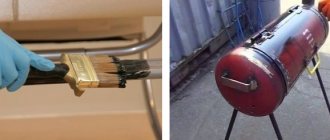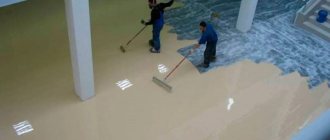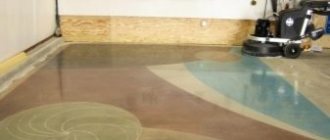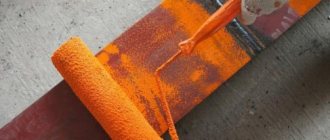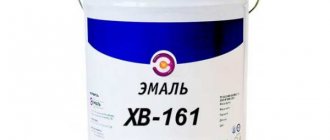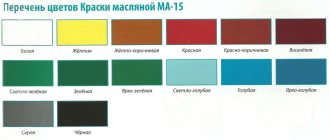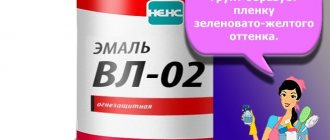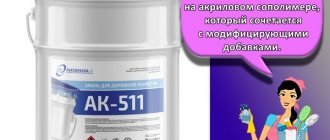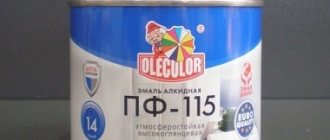Specifications
NTs-132 enamel has specific technical characteristics. They are presented in the table:
| Temperature range of use | +12…+60 degrees |
| Drying period at room temperature | 2 hours before sticking and 1 day before drying |
| Consumption | 30-120 grams per 1 square meter |
| Impact strength | minimum 50 units |
| Film hardness | minimum 0.15 units |
| Proportion of non-volatile components | 29-35% for red enamel and 32-40% for other colors |
| Conditional viscosity | 60-100 according to the V3-246 viscometer |
| Film appearance | uniform, without spots, streaks or bumps |
See also
How to find out the color of a car by VIN code and the rules for selecting paint by this number
Components
GOST 6631-74 regulates the production of NTs-132 paint. The main element nitrocellulose dictates the name - nitroenamel. The base is supplemented by alkyd resin and plasticizers. Pigments and fillers are added to the composition to give it the desired color.
Two forms of nitro enamel are available: NTs-132K, NTs-132P. They have no differences in their constituent elements. The difference is in the technical indicators of the viscosity of the compositions and their dry residue. Designation “K” - indicates that the composition is applied with a brush; letter “P” – spray technology is used.
Manufacturers produce nitro enamel in factory containers of 0.8 and 1.5 kg.
Color palette
Shades of products are regulated according to GOST. They are varied, which allows you to choose the right option depending on the type of finish. The light palette is represented by white, cream, light gray and beige tones.
Dark shades include tobacco, dark gray, gray-green, black. The color scheme also includes grey-blue, protective and dark blue-green. To get a vibrant result, you can use a golden yellow, orange-brown or red shade. There is also a red-brown tint in the palette.
In addition, you can find natural shades in the assortment of dyes. These include green-yellow, gray-green, pistachio. There are also gray-blue and light green tones. To obtain a different shade, you can order individual production.
Advantages and disadvantages
Advantages and disadvantages
Elastic composition - this helps to paint surfaces that differ in different shapes and relief.
High resistance to moisture - helps to use the dye outdoors or in damp rooms.
High wear resistance - helps maintain the original appearance of the surface for 2 years.
Ease of maintenance - associated with the resistance of the coating to the influence of cleaning or detergents, including abrasives.
Resistance to ultraviolet radiation - the enamel does not fade in the sun and does not crack.
Resistance to extreme temperatures - this helps to use enamel in aggressive environments.
The balance of quality and price makes it possible to achieve excellent results for relatively little money.
A variety of shades simplifies the choice and makes it possible to implement any design solutions. After painting, the surfaces acquire a glossy shine.
Toxicity of the liquid - in many countries the substance is sold with restrictions.
The need to comply with safety rules - it is recommended to wear personal protective equipment when working with enamel. In this case, you need to use glasses, gloves, and a respirator.
Flammable characteristics - therefore, it is not recommended to paint surfaces near heating sources with electric heating elements and open fire.
What are the characteristics of enamel nts-132 according to the GOST 6631-74 standard for nitro enamels?
Group L24
STATE STANDARD OF THE UNION OF THE USSR ENAMEL GRADES NTs-132 Technical specifications Enamels NTs-132. Specifications
OKP 23 1422
Date of introduction 1975-07-01
ENTERED INTO EFFECT by Resolution of the State Committee of Standards of the Council of Ministers of the USSR dated August 23, 1974 N 2045
TESTED in 1984 by Decree of the State Standard dated 02.20.85. Fast. N 335 validity period extended until 07/01/90*
STATUS: valid according to ROSSTANDART data of the Federal Agency for Technical Regulation and Metrology
_______________
* The validity period was removed by the Decree of the State Standard of the USSR dated December 20, 1991 N 2022. (IUS N 4, 1992). Note "CODE".
INSTEAD GOST 6631-65
REISSUE (June 1985) with Amendments No. 1, 2, approved in June 1980, February 1985 Post. 335 02.20.85 (IUS 8-80, 5-85)
Amendment No. 3 and Amendment No. 4 have been introduced, approved and put into effect by resolutions of the USSR State Committee for Product Quality Management and Standards dated 09/22/89 N 2848 from 03/01/90, dated 12/20/91 N 2022 from 07/01/92 and published in the IMS N 1, 1990, IUS No. 4, 1992
Amendments No. 3, 4 were made by the legal bureau "Code" according to the text of IUS No. 1, 1990, IUS No. 4, 1992
This standard applies to enamels of the NTs-132 grades of various colors, which are a suspension of SVP (pigment rolled with nitrocellulose, plasticizer and dispersant) in a solution of colloxylin and alkyd resin in a mixture of organic solvents with the addition of plasticizers.
NTs-132 paints are intended for painting wooden and pre-primed metal surfaces of products used in atmospheric conditions.
The coating system, consisting of two layers of enamel 132 applied to a primed surface, must maintain protective properties in a temperate climate for at least two years up to score AZ 1 according to GOST 9.407-84.
Enamels are also used for painting products used indoors.
The requirements of clause 1.5 regarding indicators 8, 9, 11, 12 are recommended, the remaining requirements of this standard are mandatory.
(Changed edition, Amendment No. 3, 4).
You can buy NC enamel from a warehouse in Yaroslavl by sending a request from the Lakokraska-Ya website.
1. NC PAINT GRADES AND TECHNICAL REQUIREMENTS
1.1. Depending on the method of application to the surface of enamel, two brands are produced:
NTs-132 K - for application with a brush;
NTs-132 P - for application by spraying.
1.2. NC paints must be produced in accordance with the requirements of this standard according to the recipe and technological regulations approved in the prescribed manner.
1.3. All 22 colors of NC paints, with the corresponding OKP codes, are indicated in the mandatory Appendix 1.
The correspondence of the changed designations of enamels colors according to GOST 6631-74 with change 3 is given in reference appendix 3.
(Changed edition, Amendment No. 2, 3).
1.4. Before use, enamel grade NTs-132 K is diluted with solvent grade 649, enamel grade NTs-132 P is diluted with solvent grade R-646 according to GOST 18188-72.
1.5. In terms of physical and mechanical characteristics, nts-132 must comply with the requirements and standards specified in table 1.
Table 1
| characteristics of nitro enamel | ||||||
| Indicator name | NTs-132 K | NTs-132 P | Test method | |||
| First grade | Second grade | First grade | Second grade | |||
| 1. Enamel film color: | Must be within the permissible deviations established by the “Card Index” color samples (standards) or control color samples | According to clause 3.3 | ||||
| red | 42, 44 | 42, 44 | ||||
| cream 200 | 200, 201 | 200, 201 | ||||
| light greenish yellow | 246, 247 | 246, 247 | ||||
| cream | 270, 271 | 270, 271 | ||||
| golden yellow | 285, 286 | 285, 286 | ||||
| pistachio 309 | 309, 328 | 309, 328 | ||||
| light gray-green | 319, 352 | 319, 352 | ||||
| pale green | 340, 360 | 340, 360 | ||||
| dark blue-green | 356, 357 | 356, 357 | ||||
| gray-green | 365, 396 | 365, 396 | ||||
| pistachio 388 | 388, 389 | 388, 389 | ||||
| light blue | 448, 467 | 448, 467 | ||||
| gray-blue | 453, 454 | 453, 454 | ||||
| gray-blue | 463, 464 | 463, 464 | ||||
| light gray 505 | 505, 513 | 505, 513 | ||||
| light gray 583 | 583, 584 | 583, 584 | ||||
| light beige | 620, 621 | 620, 621 | ||||
| red-brown | 635, 636 | 635, 636 | ||||
| orange-brown | 673, 674 | 673, 674 | ||||
| protective | 753, 754 | 753, 754 | ||||
| tobacco | 794, 795 | 794, 795 | ||||
| dark grey | 812, 813 | 812, 813 | ||||
| white | Color samples | |||||
| black | Color samples | |||||
| 2. Appearance of the enamel film | After drying, the enamel film should be smooth, uniform, without wrinkles or foreign inclusions. | According to clause 3.3 | ||||
| 3. Film gloss, %, not less | 55 | 40 | 55 | 40 | According to GOST 896-69 | |
| 4. Conditional viscosity at temperature (20.0±0.5) °C according to a viscometer type VZ-246 (or VZ-4), s | 100-150 | 60-100 | According to GOST 8420-74 and clause 3.3a of this standard | |||
| 5. Mass fraction of non-volatile substances, %, for enamel: | According to GOST 17537-72 and clause 3.3b of this standard | |||||
| black | 22-28 | 22-28 | ||||
| red | 29-35 | 29-35 | ||||
| other colors | 32-40 | 32-40 | ||||
| 6. Covering power of the dried film, g/m, no more, for enamel: | According to GOST 8784-75, section 1 | |||||
| red | 80 | 80 | ||||
| cream 200 | 100 | 100 | ||||
| light greenish yellow | 80 | 80 | ||||
| cream 270 | 100 | 100 | ||||
| golden yellow | 90 | 90 | ||||
| pistachio 309 | 50 | 50 | ||||
| light gray-green | 60 | 60 | ||||
| pale green | 60 | 60 | ||||
| dark blue-green | 30 | 30 | 30 | 30 | ||
| pistachio 388 | 50 | 50 | 50 | 50 | ||
| gray-green | 50 | 50 | 50 | 50 | ||
| light blue | 80 | 80 | 80 | 80 | ||
| gray-blue | 40 | 40 | 40 | 40 | ||
| gray-blue | 50 | 50 | 50 | 50 | ||
| light gray 505 | 50 | 50 | 50 | 50 | ||
| light gray 583 | 45 | 45 | 45 | 45 | ||
| light beige | 60 | 60 | 60 | 60 | ||
| red-brown | 40 | 40 | 40 | 40 | ||
| orange-brown | 80 | 80 | 80 | 80 | ||
| protective | 60 | 60 | 60 | 60 | ||
| tobacco | 40 | 40 | 40 | 40 | ||
| dark gray | 40 | 40 | 40 | 40 | ||
| white | 100 | 120 | 100 | 120 | ||
| black | 30 | 30 | 30 | 30 | ||
| 7. Drying time of enamel film 132 at a temperature of (20 ± 2) °C, h, no more than: | According to GOST 19007-73 and clause 3.4 of this standard | |||||
| up to degree 3 | 2 | 3 | 2 | 3 | ||
| up to degree 4 | 24 | 24 | 24 | 24 | ||
| 8. Elasticity of the film, when bending, mm, no more | 1 | 1 | 1 | 1 | According to GOST 6806-73 | |
| 9. Film strength upon impact with a U-1 type device, cm, not less | 50 | 50 | 50 | 50 | According to GOST 4765-73 | |
| 10. Film hardness, conventional units, not less than: | According to GOST 5233-89 | |||||
| using a pendulum device type M-3 | 0,30 | 0,22 | 0,30 | 0,22 | ||
| using a pendulum device type TML (pendulum A) | 0,15 | — | 0,15 | — | ||
| 11. Resistance of the enamel film at a temperature of (20±2) °C to the static effects of water, h, not less | 1 | 1 | 1 | 1 | According to GOST 9.403-80 (section 2) and clause 3.5 of this standard | |
| 12. Resistance of the enamel film at a temperature of (20 ± 2) °C to the static effects of industrial oil, h, not less | 6 | 6 | 6 | 6 | According to GOST 9.403-80 (section 2) and clause 3.5 of this standard | |
Notes:
1. It is allowed to use a VZ-4 type viscometer to measure conditional viscosity until 01/01/93.
2. The norm for indicator 10 when determined on an M-3 type device is valid until 01/01/95; on a TML type device (pendulum A) it is not rejected until 01/01/95. Definition is required.
(Changed edition, Amendment No. 2, 3, 4).
2. ACCEPTANCE
2.1. Acceptance rules - according to GOST 9980.1-86.
2.2. The manufacturer determines the norm for indicator 3 of Table 1 periodically in every hundredth batch.
2.3. The need for testing according to the recommended indicators of Table 1 (8, 9, 11, 12) is determined by the manufacturer and the consumer when concluding a contract for the supply of products.
2.4. Every hundredth batch is subjected to periodic testing for compliance with all requirements and standards of this standard.
2.5. If unsatisfactory results of periodic tests are obtained, the manufacturer checks each batch until satisfactory test results are obtained in a row of at least three batches.
Section 2. (Changed edition, Amendment No. 4).
3. TEST METHODS
3.1. Sampling - according to GOST 9980.2-86.
(Changed edition, Amendment No. 3).
3.2. Preparing samples for testing
The hardness and gloss of the film are determined on special-purpose glass plates measuring 90x120 mm and thickness 1.2 mm according to TU 21-0284461-058-90. The elasticity of the film during bending is determined on plates made of black tin according to GOST 13345-85, 20x150 mm in size and 0.25-0.32 mm thick.
The strength of the film upon impact is determined on sheet steel plates in accordance with GOST 16523-89, 70x150 mm in size and 0.5 mm thick.
All other indicators are determined on plates made of black tin or sheet steel measuring 70X150 mm. Plates for coating are prepared in accordance with GOST 8832-76, section 3.
Conditional viscosity, mass fraction of non-volatile substances and degree of grinding are determined in undiluted enamels.
The tested enamel is diluted with appropriate solvents to a viscosity of 18-20 s using a viscometer type B3-246 (or VZ-4) with a nozzle diameter of 4 mm, filtered through a sieve with mesh N 01-02 according to GOST 6613-86 and applied to prepared plates in one coat with a paint sprayer. The thickness of the dried film of a single-layer coating should be 18-23 microns.
To determine color, appearance and gloss, enamel is applied to the plates in two layers. The thickness of the two-layer coating is 35-45 microns.
To determine the resistance of the enamel film to the static effects of water and mineral oil, the enamel is applied in two layers over a glypthal or pentaphthalic primer, and the primer is applied to both sides of the plate. The thickness of the coating system should be 45-55 microns.
Drying of the second layer of enamel when determining color and appearance and the last layer when determining hiding power is carried out at (20±2) °C for 3 hours, and for enamel of the first quality quality - for 2 hours.
To determine all other indicators, drying of a single-layer coating and the second layer of a two-layer coating is carried out according to paragraph 8 of Table 1 to degree 4 or at a temperature of 60 ° C for 3 hours. Tests for indicators 3, 8, 9, 10 of Table 1 are carried out without holding samples after cold drying and 3 hours at a temperature of (20±2) °C after hot drying.
Drying between layers is carried out at a temperature of (20±2) °C for 1 hour.
In case of disagreement in assessing the quality of enamels, drying of the coating to determine the indicators for points 3, 9, 10, 11, 12 of table 1 is carried out according to point 8 of table 1 to degree 4. (Amended edition, Amendment No. 2, 3, 4 ).
3.3. The color of the dried enamel film is determined by visual comparison with the color of the corresponding samples (standards) of the “Card Index” color or control color samples in natural or artificial daylight diffused light. The samples being compared should be in the same plane at a distance of 300-500 mm from the observer’s eyes at a viewing angle that excludes surface gloss. In cases of disagreement in the assessment, the determination of color in natural daylight is taken as the final result.
The appearance of the dried enamel film is determined visually in diffuse daylight. (Changed edition, Amendment No. 3).
3.3a. Conditional viscosity is determined using a viscometer type VZ-246 (or VZ-4) with a nozzle diameter of 4 mm. (Changed edition, Amendment No. 3).
3.3b. The mass fraction of non-volatile substances is determined according to GOST 17537-72. A sample of the tested enamel weighing 1.5-2 g is placed in a drying oven and maintained at a temperature of (105±2) °C. The first weighing is carried out after 1.5 hours of exposure in the cabinet, and subsequent weighings are carried out every 30 minutes until constant weight.
It is allowed to determine the mass fraction of non-volatile substances under an infrared lamp at a temperature of (105±2) °C. If there is disagreement in the assessment of the mass fraction of non-volatile substances, the final result is determination in an oven. (Introduced additionally, Amendment No. 2).
3.4. Drying time is determined according to GOST 19007-73.
When determining the drying time to degree 3, minor marks are allowed.
3.5. Determination of the resistance of the enamel film to the static effects of water and industrial oil.
3.5.1. The resistance of the film to the static effects of water and industrial oil is determined according to GOST 9.403-80, section 2, using distilled water according to GOST 6709-72 and industrial oil according to GOST 20799-88. Painted and dried samples are placed in the test solution at 2/3 of the height and the plates are kept in it for the time specified in paragraph 12 of Table 1. After the test, the plates with the film are kept in air for 2 hours at a temperature of (20±2) °C and the appearance of the film is examined.
Slight lightening and dulling when tested in water and very slight darkening when tested in oil is acceptable. (Changed edition, Amendment No. 1, 2, 3).
4. PACKAGING, MARKING OF ENAMEL PAINT NC 132. TRANSPORTATION AND STORAGE
4.1. Enamels packaging - according to GOST 9980.3-86, group 5.
4.2. Marking of enamels is in accordance with GOST 9980.4-86.
The transport container must additionally be marked with a danger sign in accordance with GOST 19433-88 (class 3, classification code 3313).
4.3. Transportation and storage - according to GOST 9980.5-86. Section 4. (Changed edition, Amendment No. 3). 5. GUARANTEE OF THE MANUFACTURER OF ENAMEL NTs 132 GOST 6631 74
5.1. The manufacturer of nitro paint guarantees that the enamel meets all the requirements of this standard, subject to storage and transportation conditions.
(Changed edition, Amendment No. 2).
5.2. The guaranteed shelf life of enamels is one year from the date of manufacture. During storage, a decrease in the viscosity of enamels below the established norm is allowed, provided that the enamel complies with the other requirements of this standard.
5.1; 5.2. (Changed edition, Amendment No. 2).
6. SAFETY REQUIREMENTS
6.1. Enamels of the NTs-132 grades are flammable and toxic materials, which is due to the properties of the solvents included in their composition.
(Changed edition, Amendment No. 3).
6.2. During the production, testing and use of enamels, the requirements of fire safety and industrial sanitation rules in accordance with GOST 12.3.005-75 must be strictly observed.
6.3. All work related to the manufacture, use and testing of enamels must be carried out in production premises equipped with supply and exhaust ventilation and fire-fighting equipment.
Fire extinguishing agents: sand, felt, OP-5 fire extinguishers, foam installations, fire extinguishing installations with ethyl bromide.
6.4. Indicators of toxicity and fire hazard of solvents are given in Table 2. table 2
| Temperature, °C | |||||
| Solvent name | Maximum permissible concentration in the air of the working area of industrial premises, mg/m | flashes | self-ignition | Concentration flammability limits, % (by volume) | Hazard Class |
| Butyl acetate | 200 | 29 | 370 | 2,2-14,7 | 4 |
| Acetone | 200 | Minus 18 | 500 | 2,2-13 | 4 |
| Ethanol | 1000 | 10 | 404 | 3,6-19 | 4 |
| Butyl alcohol | 10 | 34 | 345 | 1,7-12,0 | 3 |
| Xylene | 50 | Not lower than 23 | Above 450 | 1,0-6,0 | 3 |
| Toluene | 50 | 4 | 536 | 1,25-6,7 | 3 |
(Changed edition, Amendment No. 2, 3, 4).
6.5. Persons associated with the manufacture, use and testing of enamels must be provided with personal protective equipment in accordance with GOST 12.4.011-89. (Changed edition, Amendment No. 2, 3, 4).
6.6. Control over the content of maximum permissible emissions (MPE) into the atmosphere - in accordance with GOST 17.2.3.02-78. (Introduced additionally, Amendment No. 3).
APPENDIX 1 Colors NTs-132
| Color name | OKP code for the brand | |||
| NTs-132P | NTs-132K | |||
| Second grade | First grade | Second grade | First grade | |
| Red | 23 1422 0106 07 | 23 1422 1206 00 | 23 1422 0206 04 | 23 1422 1306 08 |
| Cream 200 | 23 1422 0114 07 | 23 1422 1214 00 | 23 1422 0214 04 | 23 1422 1314 08 |
| Light greenish yellow | 23 1422 0187 01 | 23 1422 1287 05 | 23 1422 0287 09 | 23 1422 1387 02 |
| Cream 270 | 23 1422 0179 01 | 23 1422 1279 05 | 23 1422 0279 09 | 23 1422 1379 02 |
| Golden yellow | 23 1422 0104 09 | 23 1422 1204 02 | 23 1422 0204 06 | 23 1422 1304 10 |
| Pistachio 309 | 23 1422 0167 05 | 23 1422 1267 09 | 23 1422 0267 02 | 23 1422 1367 06 |
| Light gray-green | 23 1422 0173 07 | 23 1422 1273 00 | 23 1422 0273 04 | 23 1422 1373 08 |
| Pale green | 23 1422 0108 05 | 23 1422 1208 09 | 23 1422 0208 02 | 23 1422 1308 06 |
| Dark blue-green | 23 1422 0175 05 | 23 1422 1275 09 | 23 1422 0275 02 | 23 1422 1375 06 |
| Gray-green | 23 1422 0156 08 | 23 1422 1256 01 | 23 1422 0256 05 | 23 1422 1356 09 |
| Pistachio 388 | 23 1422 0143 02 | 23 1492 1243 06 | 23 1422 0243 10 | 23 1422 1343 03 |
| Light blue | 23 1422 0171 09 | 23 1422 1271 02 | 23 1422 0271 06 | 23 1422 1371 10 |
| Gray blue | 23 1422 0107 06 | 23 1422 1207 10 | 23 1422 0207 03 | 23 1422 1307 07 |
| Gray-blue | 23 1422 0155 09 | 23 1422 1255 02 | 23 1422 0255 06 | 23 1422 1355 10 |
| Light gray 505 | 23 1422 0159 05 | 23 1422 1259 09 | 23 1422 0259 02 | 23 1422 1359 06 |
| Light gray 583 | 23 1422 0103 10 | 23 1422 1203 03 | 23 1122 0203 07 | 23 1422 1303 00 |
| Light beige | 23 1422 0196 00 | 23 1422 1296 04 | 23 1422 0296 08 | 23 1422 1396 01 |
| Red-brown | 23 1422 0158 06 | 23 1422 1258 10 | 23 1422 0258 03 | 23 1422 1358 07 |
| Orange-brown | 23 1422 0169 03 | 23 1422 1269 07 | 23 1422 0269 00 | 23 1422 1369 04 |
| Protective | 23 1422 0111 10 | 23 1422 1211 03 | 23 1422 0211 07 | 23 1422 1311 00 |
| Tobacco | 23 1422 0145 00 | 23 1422 1245 04 | 23 1422 0245 08 | 23 1422 1345 01 |
| Dark grey | 23 1422 0160 01 | 23 1422 1260 05 | 23 1422 0260 09 | 23 1422 1360 02 |
| White | 23 1422 0101 01 | 23 1422 1201 05 | 23 1422 0201 09 | 23 1422 1301 02 |
| Black | 23 1422 0102 00 | 23 1422 1202 04 | 23 1422 0202 08 | 23 1422 1302 01 |
Appendix 1. (Changed edition, Amendment No. 3).
APPENDIX 2 (mandatory). PURPOSE, METHOD OF APPLICATION AND PRECAUTIONS WHEN HANDLING ENAMEL GRADES NTs-132 INTENDED FOR RETAIL TRADE
Enamels of grade NTs-132 are intended for painting wooden and pre-primed metal surfaces of products used in atmospheric conditions and indoors.
Before use, the enamel is thoroughly mixed, NTs-132K enamels are diluted with grade 649 solvent, NTs-132P grade enamel is diluted with grade 646 solvent according to GOST 18188-72.
Enamels of the NTs-132K brand are applied with a brush, and the NTs-132P brand is applied by spraying in an even layer onto a dry surface, previously cleaned of dust, grease, dirt and old exfoliated enamel in two layers.
Drying time for each layer at (20±2) °C is 3 hours.
Depending on the color, enamel consumption for a single-layer coating is 30-120 g/m.
Enamels are stored in carefully closed containers, protected from moisture, heat and direct sunlight.
Precautionary measures: when carrying out painting work, as well as after its completion, it is necessary to thoroughly ventilate the room: rubber gloves should be used to protect hands.
Keep away from fire.
APPENDIX 3 (for reference). TABLE OF CORRESPONDENCE OF CHANGED COLOR DESIGNATIONS OF NC-132 ENAMELS AND COLOR STANDARD CARD NUMBERS
| Enamels color according to GOST 6631-74 with change N 2 | Enamels color according to GOST 6631-74 with change N 3 | ||
| Color | Card file color sample number | Color | Card file color sample number |
| Red | 44, tolerance according to approved sample | Red | 42, 44 |
| Light green-yellow | 246, approval according to approved sample | Light green-yellow | 246, 247 |
| Pistachio | According to the approved sample within tolerances | Pistachio 309 | 309, 328 |
| Light gray 505 | 505, approval according to approved sample | Light gray 505 | 505, 513 |
| Pale green | 340, 368 | Pale green | 340, 360 |
| Gray-green | 365, tolerance according to approved sample | Gray-green | 365, 396 |
| Gray blue | 465, 466 | Gray blue | 453, 454 |
| Light gray-green | According to the approved sample within tolerances | Light gray-green | 319, 352 |
| Protective | 753, approval according to approved sample | Protective | 753, 754 |
| White | Within the tolerances of the approved color sample | White | Color samples |
| Black | Within the tolerances of the approved color sample | Black | Color samples |
Appendix 3. (Changed edition, Amendment No. 3).
The text of the document is verified according to: official publication M.: Standards Publishing House, 1985
The legal bureau "Code" introduced Amendments No. 3 and No. 4 into the text of the document, approved by resolutions of the State Standard of the USSR dated 09.22.89 N 2848, dated 12.20.91 N 2022
Rules of application
Before painting, you should take time to prepare the surface. It is cleaned of dirt, stains and debris. If there is rust, it must be removed. Metal surfaces should be primed in advance. In this case, you can use different types of primer - GF-032, FL-03K, GF-020-021. Formulations of dim shades can be mixed with solvent 646 in a 5:1 ratio and used as a primer. It is also advisable to pre-coat wooden surfaces with a primer. However, this is not necessary.
See also
How you can get peach color and its shades when mixing paints
The surface must be completely dry before applying the substance. In this case, the dye should be stirred to remove the thick film from the surface. If the substance has become too thick, it is permissible to use solvent 646. It is worth applying the composition taking into account the type of dye. To do this, use a brush or spray.
Expert opinion
Zakharova Irina Yurievna
Cleaning professional with 15 years of experience. Our best expert.
Ask a Question
After applying the layer, wait 2.5 hours. After this, you can apply the composition again. It is permissible to polish the coating only after complete drying.


